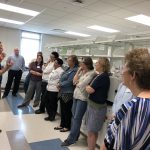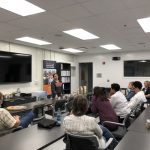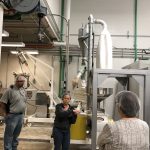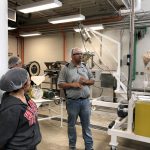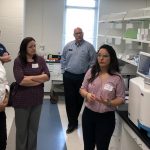AOCS January 2023 – INFORM Magazine
By Stacy Kish
Everyone has that friend, neighbor, or relative. They make the best homemade barbeque sauce or delicious pastries. Inevitably, they decide to take a shot at making more people aware of their hidden gift. Bringing a new product to market is complicated. Students studying food science rarely broach this topic, much less an accountant who has perfected raspberry jam.
THE HOME CHEF AND THE COTTAGE INDUSTRY
The entry point for most people is the cottage food industry. In the United States, a cottage food is one created at home in an unlicensed kitchen for distribution in a small market. For this reason, most cottage foods are classified by the Food and Drug Administration (FDA) as ‘lowrisk,’ like breads, baked goods, fruit jams, dried soup mixes and spice blends, roasted coffee beans, and hard candies. Conversely, ‘high-risk’ foods require refrigeration, like meat, dairy, eggs, pickled foods, and cooked plant-based foods.
Brittan Browning, owner of Gilmer Farms, always enjoyed making jam (https://www.simplygilmer.com/). She knew her product could compete with products on the market, even at high-end grocery stores. Browning decided to try and quickly learned how sticky navigating the cottage food industry could get.
“There is no one to help you, which is a huge obstacle,” said Browning. “Adding to that, I do not see any good way to scale a product while maintaining the quality you get in the home kitchen.”
Cottage food producers enter the marketplace at small venues, like a farmers market. Their products are still subject to many laws and regulations to ensure food safety requirements are maintained and label requirements met. Every state in the US, except New Jersey, has specific laws associated with human-grade cottage-industry foods. In the absence of state-specific laws, the home cook is subject to the same laws as large companies, like Campbell’s Foodservice.

Browning says navigating all the US laws was like figuring out a complicated maze. “You have to be really motivated to get through the tall corn to get to the end.”
AN EYE ON A LARGER MARKET
Jumping from a cottage to large-scale production is even more complicated. Identifying someone in the food industry or coordinating with a consulting company may be the easiest way to navigate what may seem like a daunting process.
Dustin Kelly, founder and CEO of Autumn Berry Inspired, LLC, says he envisioned that food processing companies across the country would be able to receive the fruit he harvested regionally, and make the products he had developed (https://autumnberryinspired.com/). Kelly creates jams, fruit leathers, and unsweetened puree from the Autumn Olive tree fruit, an invasive species with an otherwise useless fruit. “I found there was a shortage of food processors, and even fewer willing to work with such small quantities,” he said.


Brian Jacobson, associate director of strategic operations at the Integrated Bioprocessing Research Laboratory (IBRL) at the University of Illinois at Urbana-Champaign, helps small producers bring new products to market (https://ibrl.aces.illinois.edu/). The IBRL allows producers to work with raw materials and industrial fermentation to produce the food, fuel, feed, and fibers in their final products. In addition to the IBRL, the College of ACES also maintains a sister facility known as the Food Science & Human Nutrition Pilot Processing Plant (FSHNPPP) to assist in more traditional food production, like purees, jams, sauces, and canned foods (https://pilotplant.aces.illinoisedu/).
“Our program offers all of the ‘critical ingredients’ to help companies large or small,” said Jacobson. “We provide a strong hands-on teaching environment to help train our current and future workforce about different topics related to large-scale production, flexible facilities and equipment to scale up and test recipes or small production trials, and a strong network of industry experts including equipment vendors, production partners, and ingredient suppliers.”
The IBRL and FSHN-PPP facilities provide an interim step to full-scale production at a co-manufacturing facility so the home producer can increase production from five gallons to 1,000 gallons and work out the kinks in their recipe as they scale up the production process. Once the process is defined, the producer can take the modified ingredient list and recipe to a co-manufacturing plant and produce enough product to stock grocery store shelves.
While every product is unique, most common homekitchen items, like jams, sauces, and mixes, follow a seven-step process that fits within the existing manufacturing capacity of most pilot plants. New products may need to adjust the order of the steps to develop a prototype or proof-of-concept to share with investors. Some products may also require the small manufacturer to skip the home kitchen step and move directly to the pilot plant to use specialized equipment, like an extruder, to work through the production process on site.
THE STEPS TO PRODUCTION
Having successfully built a loyal following in your community through farmers market sales, an industrious entrepreneur may have their eye on large-scale manufacturing. Making this happen first requires research—research on your competition and your product’s market potential. Industry trade shows provide the latest trends in the food industry and often have displays where the latest start-up companies exhibit their wares. These events also offer informative seminars about food safety, regulations, functional ingredients, food trends, and packaging technology. When you are ready, it is time to take the seven step plunge.
Step 1: Money money money
Money makes the world go round and having secured the proper financing can make the processes of getting a new product off the ground go faster. According to A La Carte Connections, the average start-up cost to bring a new food product to market can range from $10,000 to $150,000 (https://alacarteconnections.com/free-resources/). Identifying the marketability of your product and a source of funding through investment or bank loans is a critical first step. Financing will allow you to purchase ingredients, work through the early stages of production, conduct microbiology testing, and work through the kinks of finding the right way to package, ship, store, and market the item.
Step 2: Get a lawyer
The food world is small, and people like to talk. Bringing a lawyer onto your team can help you develop important documents, like a non-disclosure agreement, which can offer peace of mind as you initiate conversations with potential investors and protect your idea in a competitive marketplace.
Step 3: Find a consultant and pilot plant facility
Contracting for space at a pilot plant can be expensive. A consultant can help you navigate the production process at the plant to reduce costs and time to development. You want to work with a consultant who is the best fit for your food product and has the knowledge on how to make your endeavor a success. You also want to partner with someone who understands your vision and that you can trust.
A pilot plant offers the home cook the freedom and flexibility to refine their ingredient list, recipe, and process for large-scale production. The consultant can help modify the home kitchen recipe in a way that will work on a large scale and with industrial equipment. The first step typically means converting ingredient volumes to weights, and some ingredients, like fresh-squeezed lemon, are replaced with a time-saving alternatives. A three or four day iterative process may be required to refine the best order in which to add and mix ingredients. This is also the time to experiment, tweaking production and ensuring the large-scale product meets the quality standards of the home kitchen creation.
“Small recipe errors can compound and slight changes in temperature can alter the taste or texture of the product substantially,” said Jacobson. “These errors can be costly and affect the production schedule or even fail an entire run, so it is best to discover them before contracting for production-scale manufacturing.”
Step 4: Understand regulations
Different food products are subject to different regulatory pathways. Meat, poultry, and processed egg products are regulated by the Food Safety Inspection Service, housed within the USDA (https://www.fsis.usda.gov/). All other products are regulated by the FDA (https://www.fda.gov/). It is helpful to become versed on the different regulatory hurdles early in the process so you can be prepared as you begin to scale production. Your food consultant can help you sort through these regulatory hurdles.
Step 5: Find a food testing lab
You want your product to be safe and pass all of the food safety regulations. It is important to find a certified lab that specializes in the testing of the class of food product you are developing. The testing covers not only food safety issues but also quality and consistency.
Step 6: Create a prototype
It is now time to take everything that you learned in the first five steps and run a batch of your product. By this stage in the process, you should have a good idea of ingredients, recipe adjustments, and the equipment needed for mass production. Step back. Take a deep breath and push the go button.
Step 7: Commercialization
Many of the steps in this list occur simultaneously. While figuring out how to scale-up production, it is helpful to find someone with expertise in marketing. This person should understand the product that you hope to bring to market and can provide guidance on potential competition so you can craft a message showing why your product is different and better. The marketing consultant should be knowledgeable on packaging and labeling of similar products already available in the marketplace to ensure your product meets consumer needs and expectations. They can also help make sure your label meets regulatory requirements to provide an accurate ingredient and nutrition list as well as how claims, like ‘high in protein,’ are presented.

“There are a lot of paths to follow to get a food product to market, and these paths can vary in complexity and expense,” said Jacobson. “Flexibility is key and can make a big difference if a product makes it to market or not.”
Kelly found the process frustrating but was able to make it work. He decided to partner with Amish jam makers who served as his co-packers and works with other small businesses to distribute his product and bring it to larger markets.
“People want to eat and make things from locally grown sources,” said Kelly. “Policy and consumer demand is returning us to a time of shared commercial kitchens, direct-to-consumer sales, and an appreciation of small batch artisan craftsmanship.”
About the Author
Stacy Kish is a science writer for INFORM and other media outlets. She can be contacted at earthspin.science@gmail.com








